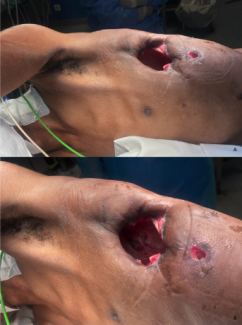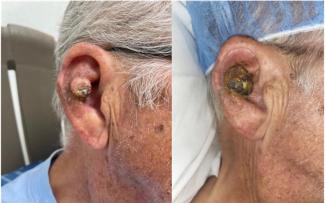Effects of Elevated Blood Alcohol Levels on Burn Patient Outcomes
Abstract
Background: Alcohol use has been associated with poor wound healing in traumatic injuries as it impairs immune function and lowers leukocyte production. The aim of this study is to describe the association of alcohol use on the outcomes of patients with burn injuries. It is proposed that the use of alcohol can have a detrimental effect on burn patient outcomes.
Methods: A retrospective review of the American Burn Association Burn Registry from 2002 through 2011 was conducted. Patients were stratified into 2 groups: burn patients with a blood alcohol level above the legal limit of 0.08 mg/dl on admission (group 1) vs burn patients with a blood alcohol level below the legal limit of 0.08 mg/dl on admission (group 2). The outcome measures included in-hospital mortality rate, hospital length of stay (LOS), intensive care unit (ICU) LOS, and total days on a ventilator.
Results: A total of 11,286 burn patients met the inclusion criteria. There were a total of 1,544 patients in group 1 and a total of 9,742 patients in group 2. The percentage of total body surface area (TBSA) involvement of the burns was statistically similar in both groups, with an average of 2.08% in group 1 and 2.32% in group 2. There was a significantly higher ICU LOS at 5.91 days in group 1 compared to 3.66 in group 2. The days on a ventilator were significantly higher in group 1 at 5.67 days versus group 2 at 3.06 days. The in-hospital mortality was also significantly higher in group 1 at 4.86% compared to group 2 at 3.91%.
Conclusion: Burn patients who tested above the legal limit for alcohol on admission were associated with increased inpatient mortality, as well as increased ICU LOS and total days on a ventilator. An elevated admission blood alcohol level may be an independent predictor of worse outcomes in patients with burn injury, leading to an increase in resource needs and health care costs.
Introduction
The use of alcohol has been associated with increased morbidity and mortality in thermal injuries. Multiple reports in the literature have noted a detrimental association between alcohol use and burns.1-8
Burn patients with associated alcohol abuse have exposure to more injury from flames and had a greater proportion of bodily burns compared to patients with no alcohol history. Data from the Ontario fire reporting system reviewed the history of 264 fire death victims and demonstrated that 31% had evidence of alcoholic impairment.9
Acute and chronic alcohol use can alter immune function and leukocyte production, resulting in frequent infectious complications. It may also result in increased resource utilization, grafting requirements, and antibiotic use, as well as prolonged hospitalization.1
Many studies have shown that age, burn size, and inhalation injuries are important predictors of mortality and morbidity following an acute burn injury. The effects of preexisting comorbidities such as alcohol abuse, however, are not well understood.10 The aim of this study is to describe the association of alcohol use on outcomes in a national compendium of patients with burn injury.
Methods
A retrospective review of the American Burn Association Burn Registry from 2002 to 2011 was conducted. Adult patients aged 21 years and above, who sustained burn injuries with no associated inhalation injury were included. Patients were stratified into 2 groups: burn patients with a blood alcohol level above the legal limit of 0.08 mg/dl on admission (group 1) versus burn patients with a blood alcohol level below the legal limit of 0.08 mg/dl on admission (group 2). Demographic characteristics and outcome variables were collected and compared between each group.
The time between injury and admission to the hospital was not available given the retrospective nature of the study. Outcome measures included in-hospital mortality rate, hospital LOS, ICU LOS, and total days on a ventilator. Infectious complications were not included in the analysis given the inconsistencies in the reports, which is a limitation of the retrospective nature of the study. Chi-squared and t-test analyses were used with significance defined as P < 0.05.
Results
A total of 11,286 burn patients met the inclusion criteria. There were 1,544 patients (13.6% of total) with a blood alcohol level equal to or above the legal limit of 0.08 mg/dl (group 1) and 9,742 patients (86.3 % of total) with blood alcohol levels below the legal limit of 0.08 mg/dl (group 2). (Table 1)

Group 1 had an average age of 37.7 years while the average age in group 2 was 34.5 years. The percentage of TBSA burn was statistically similar in both groups, with an average of 2.08% in group 1 and 2.32% in group 2 (P = 0.293, t-test).
There was a significantly higher ICU LOS at 5.91 days for patients in group 1 compared to 3.66 days for patients in group 2 (P = 0.0001, t-test). There was no statistically significant difference in the hospital LOS between the 2 groups with 11.09 days in group 1 compared to 10.94 days in group 2 (P = 0.783, t-test). Days on a ventilator were significantly higher in the alcohol positive group at 5.67 days vs 3.06 days in the alcohol negative group (P = 0.01, t-test). In-hospital mortality was significantly higher in group 1 at 4.86% compared to group 2 at 3.91% (P = 0.0001, χ2).
Discussion
Alcohol is a major cause of death in developed countries.11 A British review reported that the incidence of alcohol-related burns had significantly increased, comprising 20% of all acute admissions in tertiary burn units.11
In the present study, 1,544 patients had an increased alcohol level on admission, representing 13.6% of the study group. More than half (52.3%) of acute burn patients studied in Finland were found to be under the influence of alcohol at the time of the burn injury and have underlying dependence, implying that screening for alcohol consumption on all burn patients seems necessary.12 Albright et al also suggested routine alcohol screening upon admission based on their findings that one-third of burn patients were at-risk drinkers and more than one-fourth were binge drinkers on a monthly basis.13
Results from a retrospective study of 31,338 adult patients admitted to 70 burn centers from the American Burn Association National Burn Repository demonstrated an increase in mortality and LOS in burn patients with alcohol abuse as a preexisting condition.10 It has been previously suggested by Davis et al that alcohol intoxication at the time of burn injury alters biological response and negatively impacts outcomes, 14 which may potentially explain the findings reported in the current study.
Burn patients with elevated blood alcohol levels on admission have increased fluid requirements, increased duration of mechanical ventilation, increased ICU LOS, overall hospital LOS, and a significant increase in mean hospital charges, as indicated by Silver et al in a study of 146 burn patients with elevated blood alcohol levels on admission.15 Similar results were found in this report, as ICU LOS, days on a ventilator, and in-hospital mortality were all significantly higher in the group with increased alcohol levels. Given the retrospective nature of the study, differences in fluid requirements and surgical management between the 2 groups were not available for analysis.
Limitations
The study is a retrospective review of burn patients with elevated alcohol levels on admission and its respective outcomes; however, given the retrospective nature of it, several important points were not included. The time between injury and admission to the hospital was not available. Infectious complications were not included in the analysis given the inconsistencies in the reports. The differences in fluid requirements and surgical management between the 2 groups were also not available for analysis. Further research and analysis are needed to elucidate the effects of alcohol on these specific points.
Conclusion
Burn patients who tested above the legal limit for alcohol on admission were associated with increased inpatient mortality, as well as increased ICU LOS and days on a ventilator. A positive admission blood alcohol level may be an independent predictor of worse outcomes, leading to an increase in resource needs and health care costs.
Acknowledgments
Authors: Salomon Puyana, MD, MSa,e, Samuel Ruiz, MDa, Francisco Amador, MDd, Elizabeth Young, MSNb, Shaikh Hai, MDa, Mark McKenney, MD, MBAa,c, Rizal Lim, MDa,b, Haaris Mir, MDa,b
Affiliations: aDepartment of Surgery, Kendall Regional Medical Center, Miami, Florida; bBurn & Reconstructive Centers of Florida, Miami, Florida; cDepartment of Surgery, University of South Florida, Tampa, Florida; dDepartment of Research, Cleveland Clinic Foundation, Weston, Florida; eDepartment of Plastic Surgery, Tulane Medical Center, New Orleans, Louisiana
Correspondence: Salomon Puyana, MD, MS, 11750 SW 40th Ave, Miami, Florida 33133; salomonpuyana@gmail.com
Disclosures: There are no conflicts of interest to disclose.
References
1. McGill V, Kowal-Vern A, Fisher SG et al. The impact of substance use on mortality and mor-bidity from thermal injury. J Trauma. 1995;38(6):931–934. doi: 10.1097/00005373-199506000-00019
2. Copeland AR. Accidental fire deaths: the 5-year metropolitan Dade county experience from 1979 until 1983. Z Rechtsmed. 1985;94(1):71-79. doi: 10.1007/BF00200525
3. Jones JD, Barber B, Engrav L, Heimbach. Alcohol use and burn injury. J Burn Care Rehabil. 1991;12(2):148-152. doi: 10.1097/00004630-199103000-00012
4. Howland J, Hingson R. Alcohol as a risk factor for injuries or death due to fires and burns: re-view of the literature. Public Health Rep. 1987;102(5):475-483.
5. Lang GE, Mueller RG. Ethanol levels in burn patients. Wis Med J. 1976;75(1):S5-S6.
6. Pories SE, Gamelli RL, Vacek P, et al. Intoxication and injury. J Trauma. 1992;32(1):60-64. doi: 10.1097/00005373-199201000-00013
7. Pegg SP, Gregory JJ, Hogan PG, et al. Epidemiological pattern of adult burn injuries. Burns. 1979;5(4):326-334. doi.org/10.1016/S0305-4179(79)80007-8
8. Smith GS, Kraus JF. Alcohol and residential, recreational, and occupational injuries: a review of the epidemiologic evidence. Ann Rev Public Health. 1988;:9:99-121. doi: 10.1146/annurev.pu.09.050188.000531
9. Gerson L, Wingard D. Fire deaths and drinking: data from the Ontario fire reporting system. Am J Drug Alcohol Abuse. 1979;6(1):125-133. doi: 10.3109/00952997909007038
10. Thombs BD, Vijay AS, Halonen J, Diallo A, Milner SM. The Effects of preexisting medical comorbidities on mortality and length of hospital stay in acute burn injury. Evidence from a national sample of 31,338 adult patients. Ann Surg. 2007;245(4):629–634. doi: 10.1097/01.sla.0000250422.36168.67
11. Holmes WJ, Hold P, James MI. The increasing trend in alcohol-related burns: it's impact on a tertiary burn centre. Burns. 2010;36(6):938-943. doi: 10.1016/j.burns.2009.12.008
12. Palmu R, Partonen T, Suominen K, Vuola J, Isometsä E. Alcohol use and smoking in burn patients at the Helsinki Burn Center. Burns. 2018;44(1):158-167. doi: 10.1016/j.burns.2017.05.019
13. Albright JM, Kovacs EJ, Gamelli RL, Schermer CR. Implications of formal alcohol screening in burn patients. J Burn Care Res. 2009;30(1):62-69. doi: 10.1097/BCR.0b013e3181921f31
14. Davis CS, Esposito TJ, Palladino-Davis AG, et al. Implications of alcohol intoxication at the time of burn and smoke inhalation injury: an epidemiologic and clinical analysis. J Burn Care Res. 2013;34(1):120-126. doi: 10.1097/BCR.0b013e3182644c58
15. Silver GM, Albright JM, Schermer CR, et al. Adverse clinical outcomes associated with elevated blood alcohol levels at the time of burn injury. J Burn Care Res. 2008;29(5):784-789. doi: 10.1097/BCR.0b013e31818481bc















